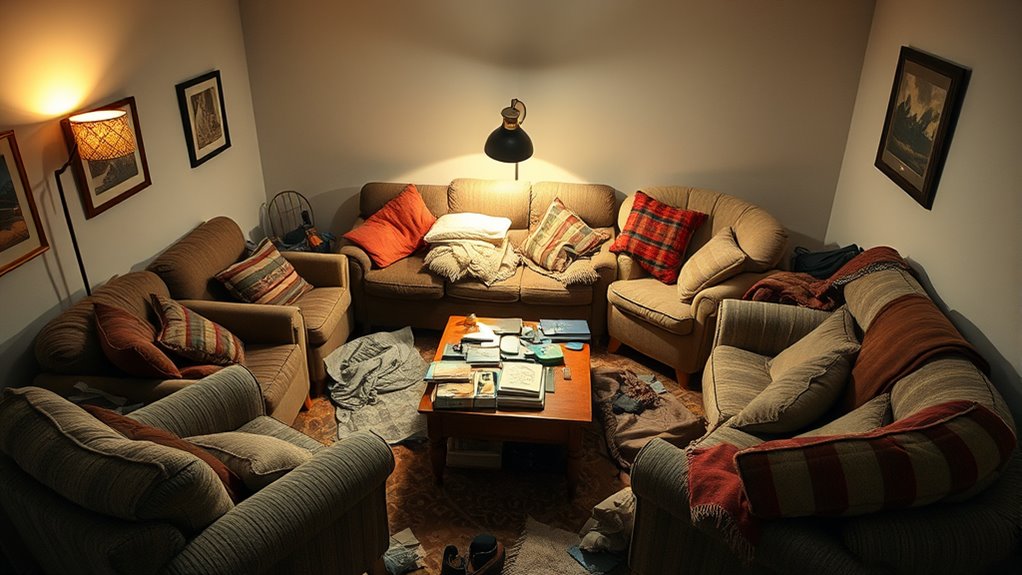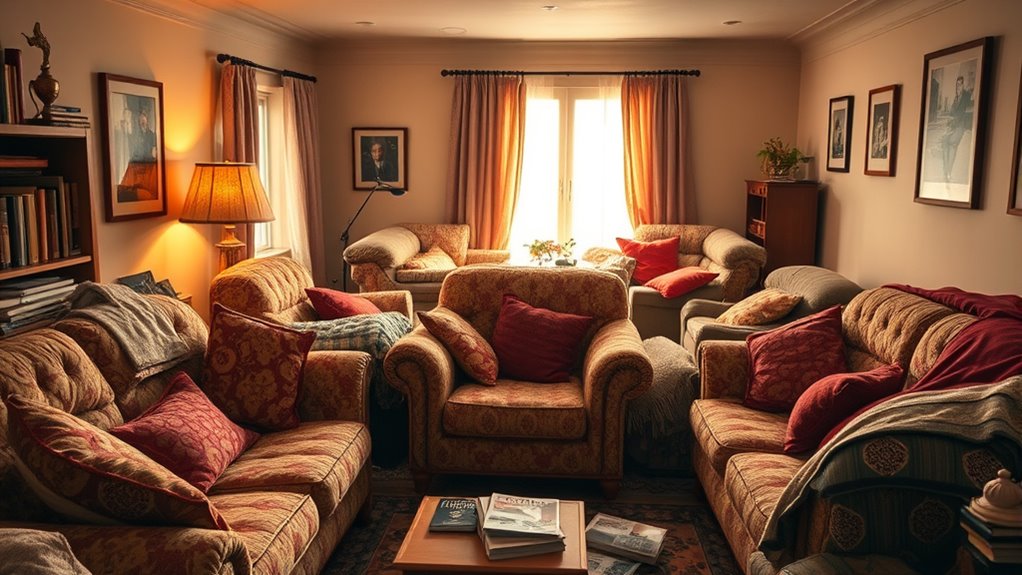If your living room feels cramped with too much furniture and narrow pathways, it can increase your stress and make you feel overwhelmed. High seating density creates a crowded atmosphere that reduces comfort and elevates tension. To feel calmer, consider rearranging furniture to open up space, use multi-functional pieces, and declutter. These adjustments can make your living space more inviting and relaxing. Keep exploring for simple tips to transform your room into a calming sanctuary.
Key Takeaways
- High seating density can make a living room feel cramped, increasing stress and feelings of overwhelm.
- Evaluating furniture placement helps identify tight groupings and narrow pathways that contribute to clutter.
- Incorporating vertical storage and choosing proportionate furniture can optimize space and reduce crowding.
- Creating clear pathways and decluttering promotes a calmer, more inviting environment.
- Thoughtful seating arrangements foster relaxed, functional spaces that decrease tension and enhance well-being.

Seating density plays a significant role in influencing stress levels, whether in crowded public spaces or workplaces. When it comes to your living room, how you arrange your furniture can dramatically impact how spacious and comfortable it feels. If you’re feeling overwhelmed or cramped, it’s likely due to poor space optimization and furniture arrangement that clutter the room or make it difficult to move freely. The key is to create a balance that fosters relaxation without sacrificing functionality.
Start by evaluating your current setup. Are your sofas and chairs grouped tightly together, leaving narrow pathways? If so, this high seating density can make the space feel congested and stressful. To improve, consider rearranging your furniture to maximize open areas. For example, angling your seating or floating furniture away from walls can create a more inviting flow, reducing the sensation of crowding. Using multi-functional pieces, like ottomans with storage, helps save space while maintaining comfort. The goal is to optimize every square foot so that each piece serves a purpose without overcrowding the room.
Rearranging furniture and angling seating can create a more open, inviting living room flow.
In terms of space optimization, don’t be afraid to get creative. Think vertically—adding shelves or wall-mounted storage can free up floor space, allowing your furniture to breathe. When selecting furniture, opt for pieces that are proportionate to your room size. Oversized couches or bulky armchairs can dominate the space and increase feelings of stress, whereas streamlined designs can make the room feel more open. Keep pathways clear so you can move easily without bumping into furniture, which reduces frustration and anxiety.
Another effective strategy is to declutter the room. Cluttered environments with excessive furniture can contribute to sensory overload, heightening stress levels. Simplify your setup by removing unnecessary items or replacing large, unnecessary pieces with slimmer alternatives. This not only enhances space optimization but also promotes a sense of calm. Consider the natural flow of movement through your living room—arrange furniture in a way that encourages conversation and interaction while maintaining enough room for individual relaxation.
Additionally, studies show that optimal seating arrangements can reduce stress and improve overall well-being. Ultimately, your living room’s comfort and your mental well-being hinge on thoughtful furniture arrangement and space optimization. When you create an environment where furniture doesn’t dominate the space, you reduce visual and physical clutter, which in turn lessens stress. By paying attention to seating density and making strategic adjustments, you can transform your living room into a sanctuary of calm and relaxation, rather than a source of tension.
Frequently Asked Questions
How Does Seating Density Affect Overall Room Functionality?
Seating density directly impacts your room’s overall functionality by influencing furniture ergonomics and visual openness. When you pack too many pieces together, it becomes harder to move comfortably and find personal space. A well-balanced arrangement improves furniture ergonomics, making sitting more comfortable, and enhances visual openness, creating a more inviting atmosphere. You should aim for a layout that balances seating needs without sacrificing room flow or making the space feel cramped.
What Are the Best Ways to Measure Seating Density?
To measure seating density, you should assess space utilization and seating comfort. Start by calculating the number of seats relative to the room’s square footage, aiming for a comfortable flow without crowding. Use a simple ratio like seats per square foot, and observe how easily people can move and relax. This helps you identify if your seating arrangement promotes both effective space use and comfortable seating for everyone.
Can Poor Seating Arrangements Influence Social Interactions?
Poor seating arrangements can definitely impact social interactions. When furniture is placed awkwardly or too far apart, it’s harder to have engaging conversations. Artificial lighting also plays a role—bright, well-positioned lighting creates a welcoming atmosphere. To improve social flow, arrange furniture to promote face-to-face contact and guarantee lighting highlights the space, making everyone feel comfortable and included. This approach encourages more natural, enjoyable interactions.
How Does Lighting Impact Perceived Crowding in a Room?
Imagine a living room with warm ambient lighting and a soft color temperature, making the space feel more open and inviting. Bright, cool lighting can make a room seem busier and more crowded, increasing perceived crowding. You can use adjustable ambient lighting to create a comfortable atmosphere, reducing stress. Proper lighting helps people feel less confined, encouraging relaxed social interactions and making the room seem less crowded.
What Are Quick Fixes for Overcrowded Living Rooms?
If your living room feels overcrowded, start with quick fixes like rearranging your furniture placement to create more open space. Opt for minimalist decorating styles that emphasize simplicity and avoid clutter. Consider removing unnecessary pieces or replacing bulky furniture with sleeker, space-saving options. Using multifunctional furniture can also help. These small changes instantly make your living room feel less crowded, more inviting, and functional.
Conclusion
So, next time your living room feels more like a sardine can, remember: overcrowding might just be your secret stress weapon. Who needs peace and quiet when you can have a cozy, claustrophobic paradise? After all, isn’t the true luxury of modern life squeezing into every available inch? Embrace the chaos—because nothing says relaxation like a room so packed, even your stress feels right at home. Cheers to living the crowded dream!









